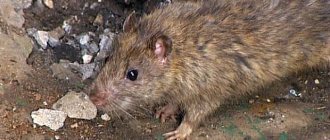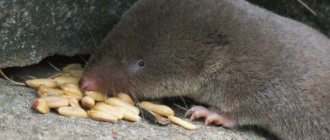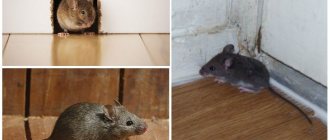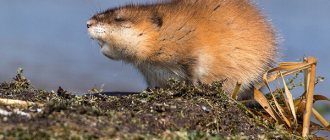You are mistaken if you think that man dominates the Earth. For a long time now, all continents, cities, villages and almost every corner of nature have been subjugated by an animal whose name is the Pasyuk rat, or simply the gray one. Most of us can't stand them. And they do the right thing, because rats eat up a huge part of the harvest, maim domestic animals and birds, and give us fatal diseases. But on the other hand, in laboratories they give their lives in thousands, helping us understand diseases, including cancer and AIDS, testing the effects of toxins and new drugs on themselves, “working” on the secrets of genetics and psychology. Do you know how the Pasyuk rat lives? How does one look for a mate? How to raise offspring? Why does it settle next to a person? We will tell you all the most interesting things about rats.
Where did they come from
12 thousand years ago, gray rats lived only in East Asia. The Ice Age left them a small space, where Eastern China is now located.
With warming, the pasyuk rat slowly occupied Altai, Primorye, Transbaikalia and southern China. But large-scale migrations occurred with the development of navigation. It was on ships that the tailed animals moved to Europe, Australia, Africa, America, populating all populated areas and suitable natural spaces. Now they are not found only in Antarctica and the Arctic. Since they arrived in new places on ships, even a certain John Berkenhout, an English naturalist, dubbed them Norwegian rats, thinking that schooners and boats came to England from there, and not knowing that at that time there were not a single rat in Norway. Despite the error, the species name Rattus norvegicus still exists today.
Appearance, origin
The appearance of the rat is quite recognizable. Like other species, the gray barn rat has an oval-shaped body 20-27 cm long, weighing up to 400 g and a hairless tail, which is sometimes the same length as the entire animal. The muzzle is wide, but slightly elongated, the whiskers are almost white. Its fur can have different shades of grayish color: reddish-brown, dirty buff or agouti; its belly is usually lighter (see photo of a gray rat below).
Pasyuk
According to biologists, the homeland of these rats is the East of China, from where they spread several centuries ago, thanks to continuous maritime trade between China and Europe. In the 18th century, the gray rat mistakenly received another name - the Norwegian rat, which was given to it by the English biologist J. Berkenhout, suggesting that the animal came to Europe from Norway.
Over the past centuries, gray rats have spread throughout the world, with the only exception being the continent of Antarctica, where it is too cold for them, and the hot African deserts, where there is no water and it is hot. They live wherever there is a source of water and quickly adapt to different climatic conditions.
Rat Pasyuk: description
Among their relatives, these rodents are considered large. Males grow up to 25 cm in length, plus a 19 cm hairless tail. In this case, the weight of an adult individual can be up to 400 grams. The sizes of females are slightly more modest. There are no other external differences. The pasyuk's muzzle is often not very elongated, and the ears are small. The fur of rats is conventionally gray, but there may also be red, dark, brownish shades, similar to those of agouti, which is why they are called brown abroad. Rarely, there are pure black and pure white Pasyuki. The abdomen of all is also white, and throughout the body there are long guard hairs, often dark at the base. There are two subspecies of pasyuks - Indian and East Asian. Rats have a chromosome set of 42 units, and they have 25,000 genes, so all sorts of combinations are possible.
Description of the animal
The gray rat, or Pasyuk, is one of the most common rodents throughout the world. The animal adapts very well to a wide variety of climatic conditions, thanks to which it can be found on all continents except Antarctica.
Appearance of the animal
In the countries of the former USSR, this representative of the mouse family is considered one of the largest. The body length of a rodent can be from 17 to 28 cm, excluding the tail.
The tail of the animal is also quite long, but always 3-5 cm shorter than the body. The average body weight of the Gray rat is 250-450 g. Some specimens can reach a weight of 900-1000 g.
The fur of young rats has a gray tint. With age, the animal's back becomes brownish or reddish. The rodent's abdomen is covered with white hairs with a dark base. Black rats are very rare.
Species features
Gray rats are pack dwellers.
The distinctive features of this type of rat are:
- structure of the skull. The parietal ridges in the Gray Rat's skull are practically straight in shape;
- aggressiveness towards strangers . Rodents most often live in colonies and always fiercely defend their territory. Animals recognize strangers by smell;
- poorly developed vision. The animal is nocturnal and navigates in space thanks to its acute hearing and sense of smell;
- dislike of heights. Pasyuki are well accustomed to apartment buildings, but are practically never found above the 8th-9th floor.
Are you afraid of rats?
Not really
Behavior
The gray pasyuk rat is a social animal; in nature it lives in groups; it rarely tolerates loneliness. One family can occupy a territory of up to 2 square km, which is carefully marked and guarded. But if necessary, called “food production,” the boundaries of the territory are easily expanded. A family can have from 100 to 2000 members. Among male rats, like other mammals, there is a strict hierarchy consisting in the selection of females for prolongation of the family. But there is no help and protection for each other here. Rats are always for themselves. They are very smart, have a good memory, if everything suits them, they are not aggressive, but they know how to stand up for themselves. Rats fight excellently, not only with their relatives, but also with large animals. Previously, English sirs even staged spectacular rat-dog fights, which, fortunately, have already been banned.
What harm does the Gray Rat cause to humans?
Rodents of this species multiply very quickly and cause many problems to humans. The main problems that arise due to the gray rat can be considered:
Damage to food and property . Rodents make their way into warehouses, elevators, granaries, mills, bakeries and residential buildings, and destroy or damage food supplies. In addition, they often chew through cables, automatic alarm systems, television, communications, and can damage various industrial products.
The gray rat is one of the main carriers of various infections. They spread diseases such as rabies, plague, pseudotuberculosis, salmonellosis and many others. Pasyuk also spreads many blood-sucking parasites such as ticks, lice and fleas.
Nutrition
The pasyuk rat is an omnivorous animal. In nature, her menu includes grains, vegetables, fruits and, of course, proteins: eggs, chicks, fish, seafood (stolen or thrown onto the ground), insects, small rodents, sometimes even feces. Having settled near humans, the rats somewhat changed their gourmet tastes. Now their menu includes any leftover food, unattended food (especially grain in granaries), as well as electrical wiring, books, and other things people need. An interesting fact: in order to get a tasty morsel, a rat is able to squeeze into a hole where its relatively small head could fit. Pasyuki have chosen warehouses, basements, subways for themselves, and in their homes they freely travel through the sewer network and garbage chutes.
Prevention measures
To ensure that rats are as little interested in your home as possible, you need to monitor its condition and follow the following recommendations:
- do not leave trash and keep order in the area around the house;
- eliminate the presence of even the smallest through holes in the walls or roof;
- get rid of sources of standing water on the site;
- do not leave leftover food outside at night;
- get a cat or dog of a breed that is excellent at hunting rodents.
Reproduction
The pasyuk rat is simply fantastically prolific! The photo above shows a 3-day-old brood. These tailed animals become sexually mature at 3 months of age! Females can have up to 20 cubs in a litter. Often 3-4 mothers create a common nest to take care of the babies. Scientists have noticed that in such cubes the bodies of newborns are sometimes intertwined, and it seems that the grown-up rat pups have two or three heads. Perhaps this became the prototype of the rat king from The Nutcracker.
In nature, animals build nests in hollows or dig shallow holes. In cities they are located in any suitable place. A female who has delivered her pregnancy can conceive again within 18 hours, and her pregnancy lasts only 24 days. Can you imagine how rapidly the rat population is increasing!
Newborn baby rats are real crumbs weighing up to 5 grams. A hungry father can feast on them, and sometimes even a mother, if she thinks the children are too weak. But generally, the females are quite caring, licking their tailed children, feeding them very nutritious milk, and putting things in order in the nest.
Children remain blind for up to 17 days, but already at the age of 1 month, and sometimes at just 21 days of age, they begin to live independently. Now there are about 15-18 billion rats on Earth, almost twice as many as us humans. And this despite the fact that the growth of their population is restrained by diseases, predators, people and a too short life span, not exceeding three years even in the most ideal conditions.
Lifestyle and basic habits of the gray rat
The lifestyle and behavior of rats can be quite accurately described in two words: plasticity and versatility.
Indeed, the main feature of these animals is their highest adaptability to living conditions and the rhythm of human life. For example, gray rats living in nature or in houses lead a twilight and nocturnal lifestyle, and prefer to spend daylight hours in their shelters. Individuals living at agricultural enterprises often lead a diurnal lifestyle, collecting grain that scatters during the day, and rest at night when the garbage is removed.
On a note
Moreover, two rats living in the same house may have different activity schedules - nighttime and daytime. Even the same individual quickly reacts to changes and easily switches from one mode to another if this makes it easier to find food and reduces the risk of being noticed and caught.
Pasyuki usually live in small groups of 5-30 individuals, less often - alone or in very large organized colonies. Each group has a dominant male, who has priority when mating with females, and secondary males.
It is also useful to read: Black rats: photographs and interesting facts about the life of these rodents
Old females are kind of leaders for young animals and younger females. At the same time, neither the group nor the colony exhibits collectivity in searching and obtaining food: each animal looks for food independently (that is, there is no mythical rat king who is fed by his subordinates). Hierarchy manifests itself mainly during reproduction.
In many cases, groups are formed from the offspring of one or more females.
Each group of animals has its own territory, which they protect from rats from other families. Depending on the abundance of food, such an area can range in size from 500 to 2000 square meters, and there are trails and shelters laid out and marked with scent.
Gray rats make nests in a wide variety of secluded places - burrows, hollows, spaces under stones, cracks in walls. Sometimes these animals show remarkable architectural abilities, creating nests from grass or any other suitable materials - paper, feathers, bags.
Records
The Pasyuk rat can surprise you with its abilities. In case of danger, it jumps up to 80 cm in height, up to 1 meter in length, accelerates up to 10 km/hour, can swim in water for 3 days, and covers up to 17 km on land in a day. These animals are, one might say, extreme sportsmen. They can live and even reproduce at -18°C. Thus, in one of the meat freezers, rat nests with babies in frozen carcasses were discovered. They calmly tolerate heat up to +45°C, and even radiation up to 300 roentgens per hour. Where atomic explosions were carried out and all living creatures were destroyed, only the pasyuk rat remained unharmed. Their small ears are able to detect the smallest noise in the 40 kHz range. We only pick up up to 20 kHz, which is great for ultrasonic repellers.
But the eyesight of rats is rather weak. Their viewing angle is only 16°, so they have to turn their heads often. Of the colors they distinguish only bluish-green, but basically they see everything in gray colors.
Each individual needs only 20 grams of food per day, but in a year this amounts to 10 kg. Without food, rats can survive only 4 days. It was the search for food that became the reason for their resettlement to new territories. Pasyuki need water no less. If their menu consists only of dry food, they can live for only 5 days without drinking. If the feed contains at least 50% moisture, it lasts for almost a month without water.
Harm and benefit
Rodents that live only in nature rarely bother people. All they can do is gnaw vegetables in the garden or grain in the fields. The Pasyuk house rat is much more unpleasant. There are two varieties here - those who live with people constantly, and those who move to people only in cold weather. Both are capable of completely destroying food supplies, cutting off power to homes and entire areas by gnawing through wiring, eating the paws of poultry and rabbits, killing rabbits, chickens and other chicks. But the worst thing is that rats carry plague, typhus, Q fever, salmonellosis, helminths and other infections. For all these reasons, people are constantly fighting with pasyuks, poisoning them, setting traps.
But on the other hand, it is rats, thanks to their fantastic fertility, that are the main experimental animals on which they test medications, conduct a bunch of experiments, infecting them with all sorts of diseases, in order to later find a cure for them. Therefore, despite the damage caused by pasyuks, you need to have some respect for them.
Pets
It turns out that there are people who take great pleasure in dealing with rats and even saving them from harm. One such rat-loving community is called Felis Lynx (rats). “What happened to Pasyuk?” - This is one of the topics on their forums on the Internet. A community has been created to help everyone who wants to have a little rat at home with advice, because raising a little rat is not so easy. There are people in the community who raise exclusively domesticated animals, which are more sociable, not at all aggressive, like little living lumps that require love and care. But there are people who undertake to release wild rat pups. Pasyuki also get used to captivity, with difficulty, but they are tamed, respond to the name, and can even allow themselves to be played with. But for example, males have a harder time tolerating the appearance of a stranger in their cage, they can even bite it to death, and at first they have difficulty with cleaning the cage or food bowl.
Selection
The greater fertility of rats helps to breed numerous breeds of them. They differ mainly in the color of their eyes and fur. There are even sphinx rats (hairless), downy rats (with delicate fluff instead of fur) and double rex rats (these areas on the body that are covered with fur change throughout their lives). A hybrid of a pasyuk and a decorative rat, which has lost some of its former talents, can also be obtained. This is what they do in the “Home Pasyuk” project. Children from such a union are born not only of a wide variety of colors, but also stronger and more intelligent. True, sometimes these offspring turn out to be somewhat aggressive. In general, messing with rats is very interesting. They are affectionate, clean animals, eat little, are trained and take up very little space in the apartment.
War of blacks and grays
Once upon a time, black rats reigned supreme in Europe. They were known about and destroyed back in the ancient period, and in the Middle Ages they even organized teams of professional rat catchers. Despite all efforts, in the 14th century, millions of people died from a plague carried by black rats.
They are smaller than gray ones, do not like to move long distances and live in basements, preferring to live in attics and roofs. Now in cities the gray rat is replacing the black one, since it turned out to be less intelligent and weaker. If there is enough food, the grays do not bother their black brothers and crowd them out only when there is a shortage of food. In settlements remote from the sea, for example in Moscow, there are very few black rats left, but in coastal cities their numbers are huge, and on ships they still dominate.










